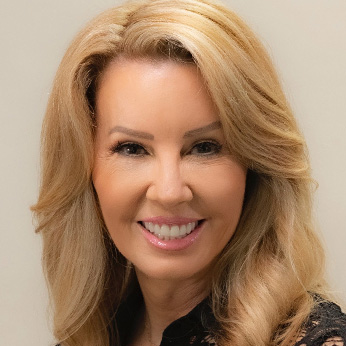- Articles & Interviews

Avoiding Anatomical Land Mines and Ensuring Patient Safety
Join us for Lori Robertson’s presentation, “Anatomical Land Mines: Safety with Dermal Fillers,” at Modern Beauty Con, on May 7, 2023, at the Boston Park Plaza.
Lori Robertson, MSN, FNP-C, believes you should never stop learning—and she has an impressively diverse résumé to prove it. Over the course of 39 years in medicine, her roles have included emergency-room and intensive-care-unit nurse, medical consultant and actress on ABC’s General Hospital, and Los Angeles Deputy Sheriff specializing in mountain rescue and underwater dive recovery.
Now she’s on a mission to develop better ways to certify aesthetic injectors.
Amid her busy schedule of teaching (she’s the cofounder of The Aesthetics Immersion) and serving clients at Skin Perfect Medical Aesthetics in Brea, California, she gave us a preview of her upcoming presentation at this year’s Modern Beauty Con and explained why she feels there is a need to standardize safety measures in the industry.
Your presentation at Modern Beauty Con this year is “Anatomical Land Mines: Safety with Dermal Fillers.” What makes this topic so important to you?
Lori Robertson: I teach all over the world and see thousands of injectors. And I find there is a lack of knowledge about anatomy and a lack of respect for possible danger zones because they’re not as aware as they need to be. I am very conservative, and I’m never going to put my patients at undue risk. I feel I owe it to them to know everything I can about what I am doing.
A lot of injectors don’t know enough about the anatomical land mines out there, and are unaware these land mines are different in every patient. I want to share how we can avert issues like potential blindness or vascular events in these areas that are being injected on a daily basis.
There is the need to increase knowledge and help patients understand. I explain to my patients about the dangers of fillers near your nose or glabella [the area between the eyebrows]. Patients need to know the risks for blindness. It is important to learn about anatomy and anatomical variations to help providers make informed decisions. These are cases that usually can’t be reversed. I never had a problem, but I don’t do noses and glabella in my clinic.
What are the best ways to learn more about anatomy?
L.R.: Cadaver courses are very important as far as education. You need to look at different cadavers because if a textbook says an artery is “here,” chances are it isn’t. Cadaver courses are huge.
The aesthetics industry is exploding. What are the biggest challenges that come with that growth?
L.R.: I’m concerned for patients. It is the Wild West out there; it is a free-for-all. There is no base certification requirement that someone must take before they inject. They can be anything from a nurse to a surgeon who has little or no experience in injecting. I would really love to see some type of standardized guidelines or certification that is accepted nationwide. ISPAN (the International Society of Plastic and Aesthetic Nurses) has a wonderful certification that is recognized, called CANS (Certified Aesthetic Nurse Specialist). It is an excellent test backed by a medical organization. The problem is, only nurses who have medical directors who are dermatologists or surgeons can sit for the exam.
What I’d like is an exam and certification that can be mandated nationwide, no matter the degree, so we can make sure people have the same foundational knowledge, and they are accountable to that. I do not believe somebody taking a one-day course should go and inject people.
On my Instagram, I have a post about how to pick a good injector. Patients don’t know. They need to ask questions. They need to validate, they need to look at their injector’s license. They need to look if they’ve ever been sued, they need to look at whether they teach. Do they read research? Do they go to conferences? Patients need to vet their providers. You don’t pick by dollar; you pick by experience. A syringe with filler is the same as a paintbrush—it depends whose hand it is in to determine the results you get. My goal is to get increased patient awareness so that they know more about how to shop for their services.
Is there a shortage of injectors?
L.R.: No, we have so many people getting into the industry. I think during the pandemic nurses and doctors got burned-out and are flocking to aesthetics. What is frightening is they are taking a one-day course that is not accredited. Some of these courses are charging a ton of money without proper education. But they are not getting the information they need to be safe providers. They are getting paint-by-numbers when they should be learning how they should choose a muscle. And many of them might be going into it for the wrong reason—just to get money. We need to always put the patient at our forefront. We need to be honest and ethical with the patient, and not just stick a syringe of filler in them to make money.
Are there new technologies enhancing services?
L.R.: Ultrasound has been a huge technology that has helped us gain safety. I spent $22,000 on a unit, and I’m not going to make money off of it, but what I can do is gain a level of safety for my injections. If there is an artery where I am going to inject, I change my location. To me, that is money well spent. Ultrasound is changing the entire way we do things, but it is a specialty in and of itself. You can’t buy one machine and take one class and think you are an ultrasound expert—I continue to take courses, and it takes a long time to learn. If you are going to buy it, you need to go to classes and learn the language.
Join us for Lori Robertson’s presentation, “Anatomical Land Mines: Safety with Dermal Fillers,” at Modern Beauty Con, on May 7, 2023, at the Boston Park Plaza.
